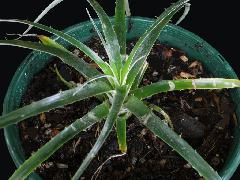
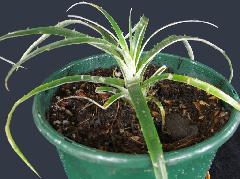
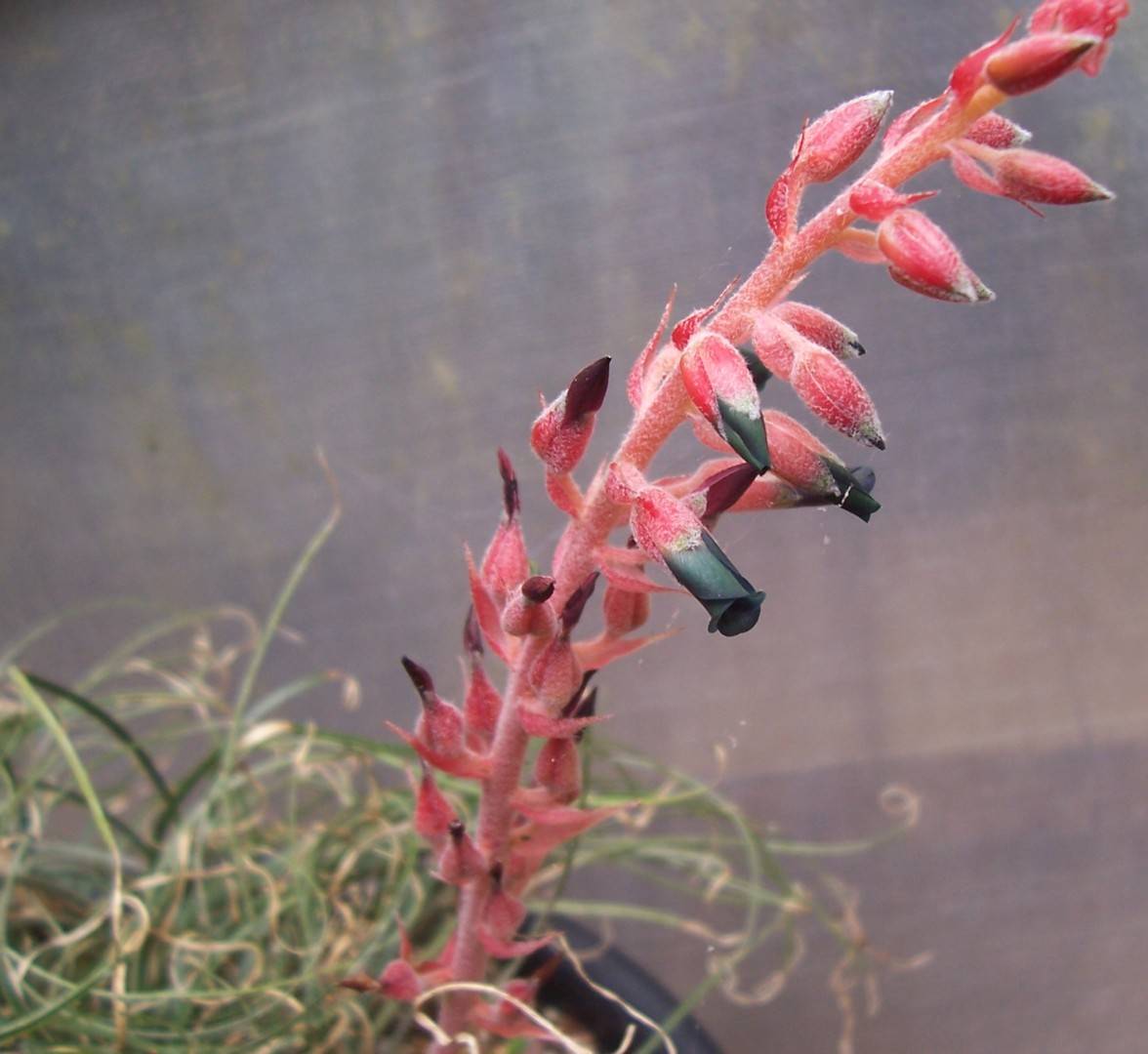
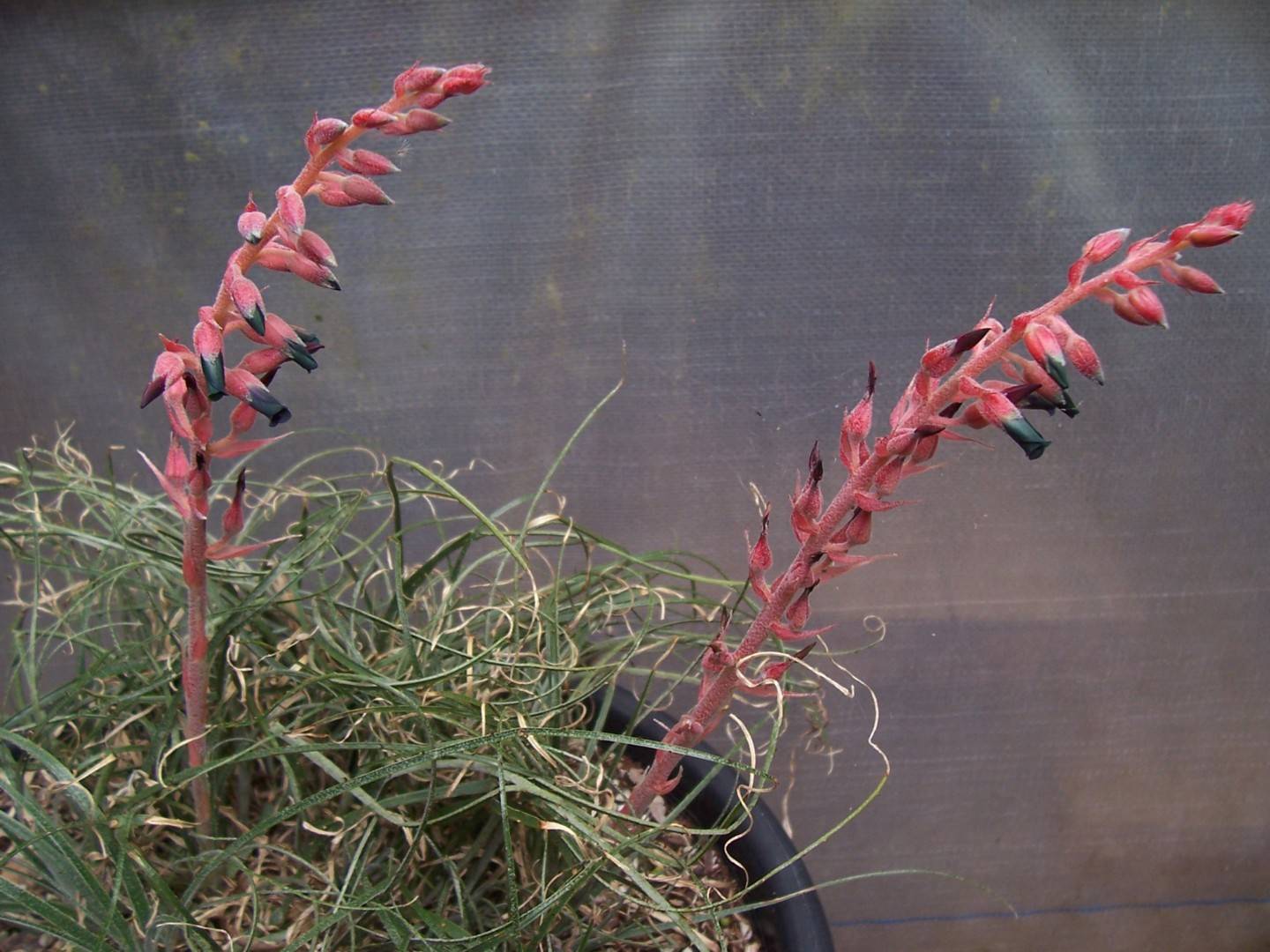
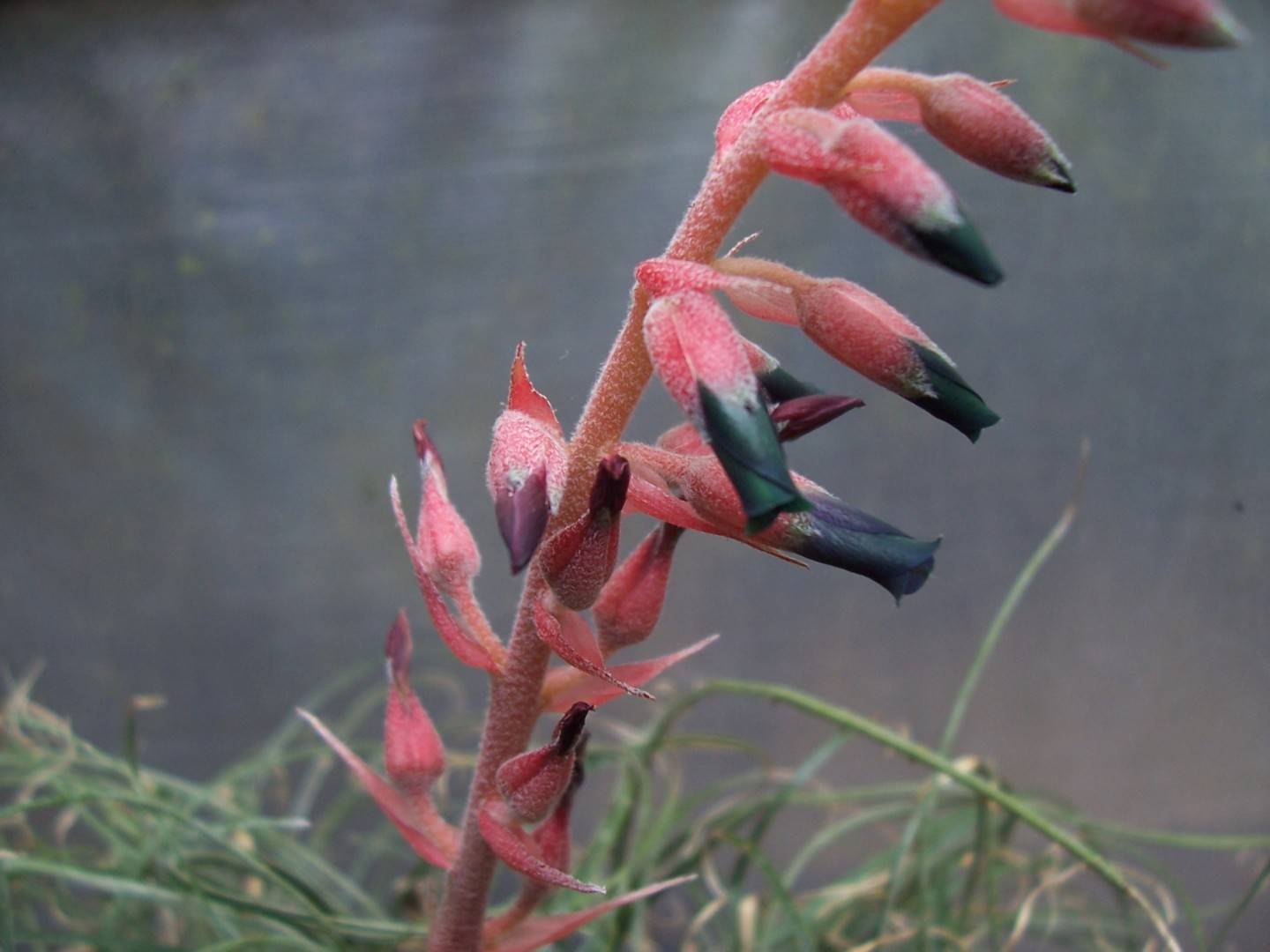









HERBARIUM SPECIMENS SEEN:CHUQUISACA: Prov. Tomina: 106 km from Monteagudo to Padilla, 2,410 m, 19°22'92”S, 64°12'79”W, October 4, 2006, R. Vasquez, J. Peters, N. Schiitz & R. Lara 5185 (herb. Vasquez); entre el puente Santa Rosa (Rio Grande) y Villa Serrano, 2200 m, 18°43'S, 64°18'W, October 5 2004, R. Vasquez, W Krahn & R. Musch 4948 (herb. Vasquez); Municipio Villa Serrano, Comunidad Nuevo Mundo, Cerro Pan de Azucar, 18°59'S, 64°17'W, 2298 m, November 30 2005, Villalobos J., Paredes M. & Villalobos D. 472 (HSB). Prov. L. Calvo: Las Frias, ca. 3 km del pueblo de Las Frias, cima de la serrania Yahuananca, 19°09'S, 63°51'W, 1552 m, December 26 2003, A. Carretero, et al. 1250 (HSB). Prov. Tomina: entre Padilla y Monteagudo, 2300 m, 19°21'S, 64°16'W, October 6 2004, R. Vasquez, W Krahn & R. Musch 4950 (herb. Vasquez). SANTA CRUZ: Prov. Florida: Cuesta de Monos, November 1950, Cardenas 4647 (LIL); ibid.: El Fuerte de Samaipata, Nov. 1954, Cardenas 5198 (US); ibid. El Fuerte de Samaipata, al borde N de las ruinas, January 23 1994, R. Vasquez et al. 2164 (LPB); El Fuerte, 1890 m, 18°10'S, 63°49'W, February 5 1994, A. Jardim et al. 343 (USZ); ibid.: laderas cercanas al Fuerte de Samaipata, 1800 m, 18º07’S, 63º38'W, June 11 2000, R. Vasquez & J. Rivero 3751 (herb. Vasquez); ibid.: 1 km antes del Fuerte de Samaipata, 1830 m, November 5 2000, R. Vasquez 3800 (herb. Vasquez); ibid.: Fuerte de Samaipata, al lado N de las ruinas, September 17 2001, R. Vasquez et al. 4255 (herb. Vasquez): ibid.: 1900 m, Samaipata, al pie de la roca de las ruinas, September 29 1981, St. G. Beck 7109 (LPB); ibid.: El Fuerte, Samaipata, 1800-200 m, ca. 63°50'S, 18°12'W, April 25 1994, P Ibisch et al. 254.gv23 (USZ); ibid.: El Fuerte, Samaipata, 18°10'S, 63°49'W, 1890 m., February 5 1994, A. Jardim et al. 343 (USZ); ibid.: Tierras Nuevas, 1980 m, 18°29'S, 63°54'W, March 10 2001, R. Vasquez & D. Ric 3865a (herb. Vasquez); ibid.: El Fuerte, 18°10'S 63°49'W, 1770 m, March 11 2006, R. Vasquez, R. Schmidt & A. Osinaga 5077 (herb. Vasquez). Prov. Vallegrande: Cruz Grande bajo La Peria, 25 Km al S de Vallegrande, camino Vallegrande-Masicuri, 2300 m, 18°36'S, 64°15'W, October 20 1992, LG. Vargas, J. Bettela & A. Bonazo 1735 (USZ); ibid.: Comunidad El Palmar, 10 km al E de la ciudad de Vallegrande, siguiendo el camino Vallegrande-Tierras Nuevas, 18°32'S, 63°55'W, 2600 m, November 5-7 1993, L G. Vargas & A. Fuentes 3046 (USZ); ibid.: Huasacanada, 5 km al S de Vallegrande, 2050 m, 18°31'S, 64°06'W, October 201992, LG. Vargas, J. Betella & A. Bonazo 1726 (USZ); ibid.: 18 km de Vallegrande a Masicuri, 2250 m, 18°35'S, 64°03'W, September 29 1993, P & C. Ibisch 93.0861 (LPB); ibid.: entre Guadalupe y Kasamonte, 2200 m, November 28 1998, R. Vasquez & J. Rivero 2998 (herb. Vasquez); ibid.: Kasamonte, cruce de los caminos Masicuri-Citanos 2450 m, November 28 1998, R. Vasquez & J. Rivero 3001 (herb. Vasquez); entre Vallegrande y Loma Larga, 2400 m, November 28 1998, R. Vasquez & J. Rivero 3102 (herb. Vasquez); ibid.: entre Vallegrande y Pucara, 2400 m, October 5 2004, R. Vasquez, W Krahn & R. Musch 4988 (herb. Vasquez); ibid.: 17 km del cruce de Trigal a Moro-Moro, 2530 m, 18°21'S, 64°10'W, October 15 2003, R. Vasquez, W Krahn, R. Krahn & A. Osinaga 4843 (herb. Vasquez); ibid.: La Ladera, 7.5 km del cruce de Guadalupe a Postrervalle, 2330 m, 18°32'S, 64°02'W, October 16 2003, R. Vasquez, W Krahn, R. Krahn & A. Osinaga 4848 (herb. Vasquez); ibid.: entre Loma Larga y el cruce a Masicuri, 18°35'S, 64°02'W, 2360 m, March 11 2006, R. Vasquez, R. Schmidt & A. Osinaga 5078 (herb. Vasquez); aprox. 15 km al S de Vallegrande, camino a Pucara, 2260 m, 18°34'S, 64°10'W, rock crevices, April 22 1987, G.S. & U. Varadarajan & J. Brandbyge 1455 (LPB).
As documented in the hitherto inedited manuscript Plantae Samaipatenses, the Bohemian botanist Thaddeus P Haenke visited the region of Samaipata (Haenke 1800).
It is probable that during this trip to the archaeological site "El Fuerte" Haenke found and collected the small puya that was described by Carl Christian Mez as Puya tuberosa (Mez 1896). The type locality is imprecise, referring the plant to Peru. In this context, it is important to know that Bolivia was called Alto Peru before gaining its independence in 1825.
In 1950 the Bolivian botanist Martin Cardenas collected a small puya close to Cuesta de Monos, near Samaipata, which was sent to Lyman B. Smith. Smith was the first to recognize that the plant from Samaipata was very similar to the type of Puya tuberosa that had not been found again since 1800. In 1954 Smith published an amendment clarifying that Puya tuberosa comes from the Bolivian territory and not from Peru (Smith 1954).
In Samaipata, for instance on the "El Fuerte" sandstone rock and its vicinities, there are two types of puyas to be observed: one is the small Puya tuberosa with filiform leaves (Fig. 4). It grows on very shallow soil, is caespitose, and has simple inflorescences. The other one grows on more profound soils, is larger and has broader and longer leaves (Fig. 5, Fig. 6). In a publication on the flora of the "El Fuerte" valley the plant was erroneously called P. dyckioides (Baker) Mez (Ibisch, Rojas et al. 1996). Observing the Samaipata plants we have come to the conclusion that it is actually the environment, which influences the morphology of the plants. Whenever the plants grow at richer and more humid sites, the plants are larger, have broader leaves (Fig. 7) and bipinnate inflorescences.
Actually, in the region of occurrence of Puya tuberosa, P. hromadnikii, P. vallo-grandensis, P. vallo-grandensis var. simplex, P. serranoensis and P. serranoensis var. brevispica it is possible to find plants that are similar to one or the other, however, representing a morphological continuum with completely unclear species limits (compare Fig. 8, Fig. 9). Actually Rauh decided to establish several new species on single specimens which do not differ very clearly. Thus we suggest that - until molecular studies shed more light on the species identities - Puya tuberosa should be understood as a morphologically more or less variable taxon which is distributed in the dry valleys of the Santa Cruz, Chuquisaca and Tarija departments.
Puya tuberosa Mez, DC. Monogr. Phan. 9: 483. 1896; emend. L. B. Smith, Contr. U. S. Nat. Herb. 29: 539, fig. 93. 1954.
Desc from S&D
Flowering plant less than 3 dm high including the very short erect rhizome.
Leaves 15-30;
sheaths suborbicular, blackish brown, pale-lepidote, forming a globose bulb 3 cm in diameter;
blades linear, flexuous, filiform-acuminate, 15-18 cm long, 2-3.5 mm wide, glabrous above, covered with pale narrow spreading scales beneath, laxly serrate with fine spreading or ascending spines 1-2 mm long.
Scape erect, slender, white-flocculose becoming glabrous
scape-bracts ovate with long filiform blades, covering relatively little of the scape, pale-lepidote.
Inflorescence simple or with a few short branches at base, cyIindric, 7-10 cm long, white-flocculose at first;
primary bracts ovate, acuminate, 2 cm long, longer or shorter than the laxly few-flowered branches, minutely serrulate.
Floral bracts ovate, acute, thin, red;
pedicels slender, 4-7 mm long, longer or shorter than the floral bracts.
Sepals lance-oblong, acute, 7-9 mm long;
petals 14 mm long, blue-violet.
TYPE. Haenke s n (holotype, M), without locality, undoubtedlv Bolivia, but originally cited as "Peru".
DISTRIBUTION. Grassy rocky slopes, 1000-1800 m alt, Santa Cruz, Bolivia.
BOLIVIA. SANTA CRUZ: Cuesta de Monos, Nov 1950, Cardenas 4647 (US); El Fuerte to Samaipata. Nov 1954, Cardenas 5198 (US).
P. hromadnikii is related to P. tuberosa Mez and P. minima L.B. Smith, two other dwarf puyas with narrow leaves from the Bolivian highlands. Both, however, according to their descriptions, seem to grow in single rosettes, while P. hromadnikii forms dense clusters. P. tuberosa is bigger than our plant and the inflorescence mostly banded. P. minima is a very small plant with a short, few-flowered inflorescence having bright red floral bracts. The color of the petals of P. tuberosa is blue-violet; in P. minima the petal color is not mentioned. In any case, this new small species of Puya with its pure white leaves is a beautiful plant which can be grown under the same conditions as cacti.
Dr. Hromadnik collected two other dwarf species of Puya in the same region, which have also flowered in the Heidelberg Garden, and which have many-branched bipinnate inflorescences. They differ from each other and are not identical with P. tuberosa; they will be described in a later issue of the Journal.
Plant stemless, branching from the base and therefore forming groups, flowering to 60 cm high. Single rosettes with weak bulbose base, to 30 cm high and to 25 cm in diam;
Leaves numerous, initially erect, later bent over to hanging.
Sheath distinct, roundish, about 2 cm broad, 1,5 cm high, upperside glabrous, white, brown towards the top, underneath chestnut brown, the top white scaled.
Blade to 30 cm long, above the sheath 5 mm wide, tapering to a long, filiform tip, channeled at the base, green, upperside almost glabrous, underneath densely white scaled. Scales tapering to a white appendage. Leaf spines inconspicuous, greenish white, 1 mm long, ± 1 cm apart.
Scape 10-20 cm long, erect, round, 5 mm thick, reddish brown, densely white woolly dusty lepidote. internodes 2.5-1.5 cm long.
Scape bracts in large numbers; the basal ones subfoliate with erect, 2-1.5 cm long, edges densely and finely spined, 5-7 mm wide, scaled, green, at the base a brown-red sheath and long, filiform, 1 mm wide, indistinctly sined blade; upper ones long acuminate, longer than the internodes.
Inflorescence laxly bipinnate, to 50 cm long and 7 cm wide, Rhachis round, cinnabar red, white woolly; internodes 2-3 cm long;
side spikes numerous, erect to spreading that hinder the basal ones in development; the longest to 7 cm long, longer than the sheaths of the primary bracta;
Top spike to 12 cm long, fertile up to the tip
Primary bracts longish oval, acuminate; the basal ones to 3 cm long, the upper ones shorter, but longer than the short, 0.5 cm long, sterile basal section of the side spike, reddish green, underneath white woolly, edges densely white and with spines.
Flowers in large numbers, laxly polystichous, stemmed,erect to spreading, at anthesis with stem to 22 mm long.
Floral bracts oval-elliptic, tapering to a sharp, green tip, raspberry red, weak (sharp when dry) keeled and nerved, underneath scattered scaled, edges strongly woolly, with spines, longer than the 3 mm long, brownish green, hairy stem, but shorter than the sepals;
Sepals 5 mm long, 3 mm wide, longish oval, short tipped spines, shiny red, underneath densely white woolly, postfloral folded in so the base of the flower seems deeply furrowed,
Petals eligulate, 15-17 mm long, forming a narrow, 3 mm thick tube, narrow lanceolate, the blunt tip bent a little outwards, dark bottle green, white towards the base, postfloral drying red violet and hardly twisted spirally;
Stamens and style enclosed. Style green in the upper section, shorter than the white filaments with yellow pollen sacks.
Pollen grains sulcate, reticulate.
Habitat and range: Bolivia, between Loma Larga and Valle Grande (Prov. Sta. Cruz) grassy rocky hillside, 2000m.,
Holotype: Hromadnik, Collection Nr. 5279 (Aug) 1981; = B.G.H. 50 823), in (HEID)
P. vallo-grandensis, named after the place of discovery in Valle Grande, is vegetatively similar to Puya hromadnikii Rauh with its narrow leaves and the rosettes branched at the base but both species differ from each other at flowering, because P. vallo-grandensis always has a richly branched, bipinnate inflorescence.
The woolly hairy inflorescence axis, the floral bracts and sepals are a shiny red colour, to which the emerald green petals contrast. A near relative may be P. micrantha Mez, whose leaves are 90 cm long; moreover the to 50 cm wide lax paniculate inflorescence, the spreading to ascending inflorescence spikes, the inflorescence axis ± glabrous and the floral bracts shorter than the pedicels. All these characteristics show P. vallo-grandensis to be a species in its own right.
Differs from the type in the simple, somewhat bent inflorescence and the longer pedicels.
Holotype: Hromradnik 5279 (= B.G.H. 50 823 a, (HEID).
Habitat and range: Bolivia, between Loma and Valle Grande (Prov. Sta. Cruz) in stony rocky grassy meadows, together with the type.
Plant stemless, flowering 20-35 cm high, forming groups.
Leaves numerous.
Sheaths distinct, 2 cm high, 2 cm wide, white to brown, in the lower part glabrous, upper half scaled.
Blade 15-35 cm long, above the sheath 3-4 mm wide, tapering to a long filiform bent back soon drying tip, weakly canaliculate, edges with 3-5 mm apart erect, brown spines, 1 mm long, both sides white felted, scales asymmetrical.
Inf1orescence 20 cm long, simple raceme, many flowered.
Scape erect, 10-15 cm long, 3 mm thick, green to a delicate pink, dense white woolly. Internodes 0.5 cm long.
Scape bracts erect, the basal ones subfoliate, the upper ones with approximately 1 cm long, adjacent to the scape, creamy white, glabrous sheath and long filiform, spiny blade, similar to the floral bracts above.
Floral bracts membranous, tender pink flesh colored, longish oval, acuminate, concave, the basal ones to 2 cm long, the upper ones shorter, 0.5 cm wide, nerved, densely scaled, edges weakly spined.
Flowers erect to spreading, at anthesis diverging, without stem 2 cm long.
Pedicels 0.5-0.8 cm long, white flaky.
Sepals free, 1 cm long, the posterior pair unclearly keeled, longish triangular, acuminate, rosy, flaky scaled.
Petals bottle green, towards the base white, longish oval, 1.6 cm long, 1 cm wide, tips spreading, postfloral lilac coloured, a little twisted.
Stamens and style enclosed; style shorter than the stamens; anthers gold-yellow, Filaments flattened.
Ovary almost fully superior; ovules numerous, probably winged seeds.
Holotype: Hromradnik 5279 = B.G.H. 50 823 a, in (HEID).
Habitat and range: as with Puya vallo-grandensis, Bolivia, between Loma Larga and Valle Grande (Prov. Sta. Cruz).
P. vallo-grandensis var. simplex occurs with a larger, more richly branched plant in larger numbers in the same area, and the simple inflorescence seems hindered in the development and seems to be homologous with the top spike raceme of a normally branched inflorescence {See. Rauh, Bromelienstudien 12. Mitteilung, abb. 4, S. 11, in Tropische und subtropische Pflanzenwelt 41, 1983,}. There is a link between normally branched and simple inflorescences, where the lateral spikes (= Paraclade), admittedly adjacent, hinder the young development stages from further development.
Habitat et distributio: Bolivia, inter Villa Serrano et Rio Grande, 2200 m.s.m. in declivibus saxoso-graminosis.
Holotypus: HROMADNIK 5230 (= B.G.H. 50 831) in herb. Inst. bot. system. univ. heidelbergensi.
Plant grows singularly, stemless, flowering to 50 cm high.
Leaves numerous, forming a to 30 cm high and 50 cm wide rosette.
Sheaths distinct, roundish, 3-3.5 cm wide, 2.5-3 cm high, underneath chestnut brown, in the upper third dusty felt like hairy, upperside shiny white, towards the top brown, forming a to 6 cm thick pseudobulb.
Blades 30-60 cm long, narrow, above the sheath 8-10 (-12) mm wide, tapering to a long, filiform, bent over tip, underneath whitish grey felt with long twisted scales, upper side becoming glabrous, green, edges with faint, small, brownish hooked spines; 6-15 mm apart. Leaf tips soom drying, old dry leaves therefore overhanging.
Scape 15-20 cm long, 8 mm thick, greenish-reddish-brownish, felt like scaled.
Scape bracts erect, the bottom ones subfoliate, with short, reddish, white scaled, sheath with fine spines on the edge and a filiform blade, the upper ones acuminate, bladeless Inflorescence about 30 cm long, 8 cm broad, laxly bipinnate, with ± 9, short (1-2 cm long) stem, to 9 cm long, to 12-flowered, erect to spreading sidespikes;
Side spikes much longer than the sheath of the primary bracts. Top spike to 15 cm long, much longer than the side branches; the axis thin, scaled.
Primary bracts: the basal ones similar to the upper scape bracts, oval, long acuminate, the upper ones longish oval, edges fine and scattered scaled, reddish scales.
Floral bracts oval acuminate, 1-1.5 cm long, thin, when dry prominently nerved scattered flaky scaled, edgee irregularly weakly spined, longer than the thin, erect, 6-7 mm long, scaled pedicel, but shorter than the sepals;
Sepals 8-10 mm long, 5-6 mm wide, short tipped, the posterior pair indistinctly keeled, pink, scattered lax flaky scaled, with entire edge.
Petals longish oval ± 16 mm long, in the upper third 9-11 mm wide, eligulat, at anthesis erect with a little bent tips, the upper half metallic dark bluish green, toward the base white, postfloral hardly spirally twisted, when dry very dark blue green.
Stamens with whitish yellow anthers a little shorter than the petals.
Filament white, flat ribbon like.
Style with the stigma shorter than the stamens.
Fruit not known.
Habitat and range: Bolivia, between Villa Serrano and Rio Grande (Prov. Sta. Cruz) on grassy rocky hillside near 2200 M.
Holotype: Hromradnik Collection-Nr. 5230, July 1979 (= B.G.H. 50 831) in (HEID).
Puya serranoensis named after its place of discovery Villa Serrano named and collected by H. HROMADNIK as a Deuterocohnia collected, however it is of the subgenus Puyopsis (Inflorescence axis visible).
Referring to the Puya key by L. B. SMITH in (Subkey, I, p. 67) in Flora Neotropica, Pitcairnioideae, we find the following characteristics: Inflorescence compound; branches of the inflorescence “more than twice as long as the sheaths of the primary bracts”; one assumes however, that the “branches of the inflorescences not more than twice as long as the primary bracts " applies (this is however not the case with the present plant), so one refers to couplet 53 according to the width of the leaf blade (10-75 mm or 2-10 mm) to reach either P. assurgens L. B. SMITH (leaf blade 10-75 mm wide) or to P. tuberosa Mez ( leaf blade 2-10 mm wide). With P. serranoensis the blade directly above the sheath is 12 mm wide at most, the remaining blade is narrower. P. assurgens differs from P. serranoensis in the following characteristics: at the base no bulb like swelling; the to 18 mm wide leaves have an underneath covered with appressed not hairy long scales; the Inflorescence is dense bipinnate with to 6 cm long, ascending side spikes and few flowered; the basal floral bracts should exceed the edge of the fine serrated sepals, the petals are green and postfloral shiny dark purple.
All these characteristics do not apply to Puya serranoensis where the leaf blade is narrow-linear, less than 10 mm wide; the Inflorescence is lax bipinnate; the primary bracts are relatively small; the sepals have entire edges; the petals at anthesis and postfloral are dark bluish green. Moreover, the type locality for P. assurgens is declared as Argentina (Jujuy) and not Bolivia.
With Puya tuberosa Mez, the bulb like base is admittedly right, but only to 3 cm in diameter with thick offsets at the base, however the foliage leaves are the same as P. tuberosa, thin filamentous (after observations of the type specimen by Haenke s., N., Bot. State-collection Munich), the inflorescence is simple or only sparingly branched, with (1-2) short, about 3 cm long, few flowered side spikes.
Inflorescence axis, scape bracts, primary bracts, and floral bracts, are like the sepals virtually glabrous in age. The petals are blue-violet, drying off wine-red.
Puya serranoensis is also related to P. vallo-grandensis: but differs from this through the formation of bulbose single rosettes, through the less strongly branched inflorescence, the very lax, not intensively carmine red coloured side spikes, as well as not through the postfloral in folded sepals.
Collectively all narrow leaved dwarf Puya species, P. minima, the very similar P. hromadnikii, P. tuberosa, P. serranoensis, P. vallo-grandensis, and maybe also P. assurgens and P. dyckioides (Baker) Mez, form a single complex in Bolivia. To clarify this question, further examinations are needed especially since other narrow leaved dwarf forms were found also in North-Peru, whose inflorescence and flowers are not known to Pang.
This new variety differs from the type in the more compact, initially dense, but at anthesis lax, to 6 cm long, cylindrical end spike and the very short, only to 2 cm long, very short stemmed, few flowered primary side spikes.
Holotype: B.G.H. 50 831a (= Hromradnik 5230, in HEID.
Habitat and range: Bolivia, between Villa Serrano and Rio Grande, 2200 m, rocky grassy slope.
Plant stemless, flowering to 50 cm high, thickened bulblike at the base, initially individual, after flowering grows into clumps.
Bulbous stem to 4 cm thick and 5 cm high covered by the leaf sheaths;
Leaf sheaths wide-roundish, to 2.5 cm wide, 1.2-1.5 cm high, distinct, underneath dark chestnut brown, in the upper half white star like hairy, upper side glabrous, white at the base, normally bright chestnut brown, edges dense brown spined.
Blades bent over, lineal, above the sheath 5 mm wide, tapering to a fine, thin, soon drying tip, underneath densely lepidote, upper side becoming glabrous, green, edges with small, prominent, forward pointing, white spines which are 5 mm apart.
Scape to 20 cm long, erect, round, 0.5 cm thick, greenish reddish, densely white flaked.
Scape bracts: the basal ones subfoliate with erect sheath and very narrow, bent over blade, the middle and upper ones erect, adjacent to the scape, with approximately 2 cm long sheath, with fine white spined edges and filiform, to 2 cm long, spiny blade,
Inf1orescence 15-17 cm long, to 3.5 cm wide, laxly bipinnate, with lax cylindrical, many-flowered, to 7 cm long and at anthesis 3.5 cm thick.
Top spike, and ± 10, short cylinder like, to 2 cm long primary side spike (the base clearly vestigial);
Primary side spikes ± 5 at the base, with very short, 2 mm long stem and each with 2-3, polystichous flowers; these are smaller than that of the Top spike, including the very short stem only 15 mm long.
Primary bracts: the basal ones similar to the upper scape bracts, diverging, longer than the side spikes, the upper ones spreading horizontal, with a long blade as long or a little shorter than the side spikes, pink-color, long acuminate, edges spiny, underneath lepidote
Flowers of the Top spike prefloral dense, at anthesis lax.
Floral bracts erect to spreading, triangular acuminate, indistinctly carinate, membranous, 8 mm long, pink-colored, lepidote, edges spiny, usually shorter than the sepals.
Flower short, (2 mm) stemmed, to 17 mm long.
Sepals longish triangular, acuminate, 8 mm wide, pink-colored, densely white lepidote.
Petals narrow tongue shaped, 16 mm long, with short bent over tips, the upper half emerald green, toward the base white, postfloral dark carmine red and twisted.
Stamens and Style enclosed. Style with stigma shorter than the yellow anthers.
Holotype: B.G.H. 50 831a (= Hromradnik 5230, in HEID.
Habitat and range: Bolivia, between Villa Serrano and Rio Grande, 2200 m, in stony meadows.
var. serranoensis
Inflorescence bipinnate, to 30 cm long, with lax many flowered Top spike. Side spikes erect to spreading, up to 12- flowered, much longer than the primary bracts. Top spike to 15 cm long, laxly many flowered.
var. brevispica Rauh
Inflorescence laxly bipinnate, to 17 ( -20) cm long.
Side spikes very short, only to 2 cm long, 3 to 5 flowered, spreading horizontal, shorter or as long as the primary bracts.
Top spike to 10 cm long, laxly to densely cylindrical, many flowered.
The var. brevispica was collected with the type (var. serranoensis) but has been proven in cultivation as a well distinguishable variety.
The flowering sequence is remarkable. First the petal tips unfold in the bottom portion of the Top spike; then later the lateral side spikes flower, again from the base.
Plant flowering to 70 cm high.
Stem bulbous, covered by the sheaths, 5 cm long, 4 cm in diameter.
Leaves 6-9 in number, rigid, thick, persistent, rosulate, curved;
sheaths broadly semilunate, to 2 cm high, 5 cm wide, light brown inside, dark castaneous, lustrous, glabrous outside, the upper margins serrate with short spines;
blades oblong-triangular, long attenuate, filiform at the apex, 17-33 cm long, 2.5 cm wide at the base, dark green to purple red, gray lepidote on both surfaces, stronger beneath; margins serrate with strong, retrorse, black, 3-7 mm long spines, covered by white scales, 6-8 mm apart.
Scape erect, 17-22 cm long, 5 mm in diameter, reddish purple, white lepidote;
scape bracts erect, lanceolate, attenuate, sparsely white lepidote, to 45 mm long, 10 mm wide, dry chartaceous, longer than the internodes; margins entire.
Inflorescence erect, to 30-45 cm long, 3-4 mm in diameter, purplish, white lepidote, simple or with 1-2 branches at the base; branches ascending in 45° angle in relation to the rachis, to 14-16 cm long;
primary bracts lanceolate, attenuate, acuminate, to 30-37 mm long, 10 mm wide, chartaceous when dry, sparsely white lepidote;
floral bracts lanceolate, chartaceous, long attenuate at the apex, to 12-25 mm long, 10 mm wide, much longer than the pedicels, the basal ones equaling the flowers, sparsely white lepidote outside.
Pedicel gray, white lepidote, 4 mm long.
Flowers ca. 120 in number, 25 mm long, spirally arranged, suberect to erect;
sepals lanceolate, mucronate, pink, darker at the apex, densely white lepidote outside, 14 mm long, 5 mm wide;
petals spathulate, white at the base, very dark purple in the exserted portion, 20 mm long, 9 mm wide, twisted together after anthesis;
stamens included, to 13 mm long; filaments white; anthers 3 mm long, fixed above the middle, dark purple; pollen yellow.
Ovary and style 9 mm long; stigma oblong, contorted, dark purple.
Capsule terminally dehiscent, conic, acute, dark brown, 10-12 mm long;
seeds triangular, curved, 1.5-2.5 mm long, narrowly winged.
Puya pachyphylla, for its size and the superficially-resembling flowers, is similar to the taxa of the complex of Puya tuberosa, but it notably differs by the few, thick, rigid and strongly, spined leaves as well as by other characters, such as the entire floral bracts, larger sepals and petals. The name is derived from the greek pachys = thick and phylla = leafed, referring to the thick and carnose leaves of this species.
Distribution, ecology and conservation: Puya pachyphylla has been exclusively recorded from higher elevations of the dry valleys which surround the village of Santa Ana in the province of Vallegrande, department of Santa Cruz, Bolivia. As with many other puyas, this species grows on stony and degraded summits and slopes covered by an open dry valley vegetation. It is sympatric with locally endemic cacti taxa such as Lobivia (Echinopsis) arachnacantha var. vallegrandensis Rausch and Aylostera (Rebutia) ityacantha Cardenas. It has been found at an altitude of 2,300-2,400 m. Flowers were observed in October. National conservation value according to (Ibisch 1998): 32+8+8+4Ci = 52: vulnerable. The observed specimens were affected by rather severe grazing by sheep that could lead to reduced seed production.